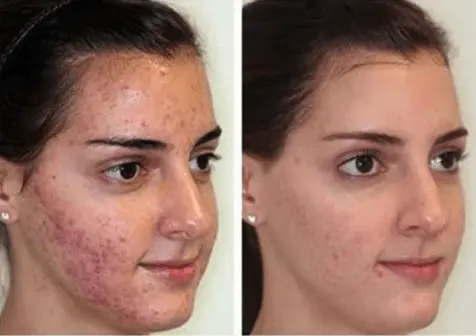Contents
- What you need to know about post-acne peeling
- Which post-acne peeling is better
- Get rid of blemishes with chemical peels
- Is it possible to do peeling from post-acne at home
- Overview of products for problem skin
- Exfoliating facial scrub with absorbent charcoal “Clean Skin Active”, Garnier
- Sugar Facial Scrub “Cleansing”, L’Oréal Paris
- Effaclar Duo(+), La Roche-Posay Corrective Cream-Gel for Problem Skin
- Deep cleansing gel against imperfections for mature skin Blemish & Age Defense, SkinCeuticals
- Lotion to reduce and prevent skin imperfections Breakout Control Blemish Treatment Facial Lotion series Dermatologist Solutions, Kiehl’s
The number one dermatological problem is acne. The “honorable” second place is occupied by post-acne – this thing does not appear for everyone, but you should not leave it unattended. Peeling is an effective way to deal with post-acne.
What you need to know about post-acne peeling
Mechanism of action
With the help of peeling under the supervision of a specialist, the surface layers of the skin are deliberately destroyed. Together with them, damage to these layers is also eliminated. Since in the case of post-acne they can be quite deep, then the impact is required deep. Although it all depends on the individual situation.
Indications for use
In addition to the popular renewal and rejuvenation, peels are used to combat hyperpigmentation and post-acne. Keep in mind: just going to the salon to get rid of scars and spots will not work. A preliminary consultation with a doctor is required.
The doctor will help you choose the right type of peeling.
Expected Result
Let’s be honest: an experienced doctor does not give any guarantees. But it is obvious that with a sufficiently deep peeling, when not only the stratum corneum is removed, but also partially the epidermis, even the most pronounced traces of acne, if they do not disappear completely, will become much less obvious. So does hyperpigmentation.
Which post-acne peeling is better
When there are no active inflammations on the skin and only traces of acne remain, almost any type of peeling is appropriate.
Chemical
Perhaps the most popular variety. With the help of acids that destroy intercellular bonds, it allows you to remove layers of epidermal cells. Thus, the damaged areas are simply removed and young, brand new skin “grows”, which did not suffer from inflammation and acne.
Mechanical
In the case of post-acne from mechanical peels, microdermabrasion is recommended.
Laser
With the help of a laser, the damaged layers of the skin are burned out, making way for young cells. The main disadvantage of this procedure is the price. Among the advantages is the ability to regulate the depth of penetration and to influence the damage in a targeted manner.
Get rid of blemishes with chemical peels
Popular peels with fruit acids, as a rule, are not used to correct post-acne, but are included in special cocktails.
Salicylic peeling
Salicylic acid, like its derivative, lipohydroxy acid, is the most important fighter against acne and, accordingly, post-acne. Here are its benefits:
exfoliates the skin;
has an antiseptic effect;
tightens pores;
affects the production of sebum.
Peeling Jessner
promotes exfoliation of skin cells;
stimulates the production of collagen.
Another component of the composition is resorcinol. This substance has a depigmenting and anti-scarring effect, which is necessary to get rid of post-acne.
yellow peeling
Medium and deep peels
A well-chosen combination of acids allows you to get rid of post-acne.
Is it possible to do peeling from post-acne at home
The best remedy for acne is prevention. That is, timely acne treatment and competent care for problem skin, which maximally supports its strength and ability to recover. And for this it is important:
competent and complete cleansing of the skin;
regular exfoliation;
moisturizing.
This approach reduces the risk of post-acne. But if traces still remain, especially fresh ones, then cosmetic peels may well give a certain result.
There are a few general rules to follow if you are undergoing procedures such as peeling.
The composition for peeling is applied in the evening on dry, cleansed skin.
On the days of peeling and for a week after the procedures, it is necessary to apply sunscreen with a high SPF before leaving the house.
Intense skin hydration is a must.
Strictly follow the manufacturer’s instructions, as home peel formulations can vary greatly and have features that need to be considered.
Overview of products for problem skin
Exfoliating facial scrub with absorbent charcoal “Clean Skin Active”, Garnier
Exfoliation with abrasive particles is combined with exfoliation and skin renewal with salicylic acid. Helps prevent acne.
Sugar Facial Scrub “Cleansing”, L’Oréal Paris
Mechanical peeling comes from three types of sugar and enzyme-rich kiwi seeds. The scrub has a warming effect, stimulating blood circulation.
Effaclar Duo(+), La Roche-Posay Corrective Cream-Gel for Problem Skin
Daily care combines exfoliating salicylic and LHA acids, as well as a probiotic and prokerade substance that prevents the formation of traces of imperfections.
Deep cleansing gel against imperfections for mature skin Blemish & Age Defense, SkinCeuticals
The complex of exfoliating acids controls the oiliness of the skin, helping to get rid of imperfections and providing exfoliation during the cleansing phase.
Lotion to reduce and prevent skin imperfections Breakout Control Blemish Treatment Facial Lotion series Dermatologist Solutions, Kiehl’s
Salicylic acid has an exfoliating effect, while vitamin B3 softens and stimulates recovery. The tool can be used up to 3 times a day. With regular use, the skin is cleansed of imperfections and their traces.
A summary of the article is in the final video.










